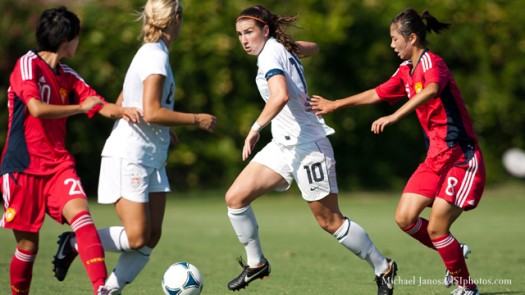Does U.S. Soccer have what it takes to carry out its women’s youth dev. initiatives?

The U.S. Soccer Federation has recently (and quietly) announced the outline of plans to revamp the development and identification of players for the women’s youth national teams. The plans are still relatively inchoate, and, unlike the parallel initiatives on the men’s side, have not even been memorialized in a public press release.
But the federation has given the media enough information to at least start to assess what they intend to do — and to raise some interesting questions about whether it will work.
+READ: U.S. Soccer quietly weighing youth development overhaul as USWNT eye future
Bracket the fact that not one word has been said about steps to limit pay-to-play and its many deleterious effects.
And put aside for the moment the not-exactly-insignificant issue of whether and how all of the various plans to raise the level of training and competition for top girls players will work — whether that be the plan to establish some sort of Development Academy-like structure of clubs, a potential residency program, increased international competition for YNT players, or offseason opportunities for college players with teams in the NWSL.
Taken on their own terms, what all of these initiatives share is a need for high-level talent identification and coaching, from the YNTs on down. And on recent evidence, there is room for doubt that this coaching-side ability and infrastructure will be in place.
 Return, for example, to last summer’s fiasco in the U-20 Women’s World Cup. The quarterfinal exit was obviously not good, but what was far more disquieting was the way the U.S. went out.
Return, for example, to last summer’s fiasco in the U-20 Women’s World Cup. The quarterfinal exit was obviously not good, but what was far more disquieting was the way the U.S. went out.
The roster choices were puzzling (not least the still-unexplained omission of Morgan Andrews), and the brand of soccer ugly, retrograde, and ineffective.
+READ: Morgan Andrews speaks: Notre Dame star undeterred by U.S. U-20 World Cup snub
The U.S. and its longball-heavy 4-2-4 approach were far outclassed, both technically and tactically, by sides, like Germany and France, that are supposed to be our peers. And yet U-20 head coach Michelle French is still in charge today.
This outcome suggests one of two possibilities: Either the WNT hierarchy thought that French’s handling of the U-20s was good enough that she should be retained, or that French shouldn’t be held responsible because it was her superiors who had actually made the key selection and style decisions.
 The former possibility calls into question the ability of top decisionmakers like April Heinrichs to assess coaching performance; the latter raises serious doubts about whether Heinrichs et al. can be relied upon to make good scouting, selection, and style choices with respect to high-level youth players at all.
The former possibility calls into question the ability of top decisionmakers like April Heinrichs to assess coaching performance; the latter raises serious doubts about whether Heinrichs et al. can be relied upon to make good scouting, selection, and style choices with respect to high-level youth players at all.
+READ: USWNT must drop Abby Wambach now, before it’s too late
Of course, it is precisely those same decisionmakers who will be determining the philosophy and staffing of the burgeoning programs that the federation has announced. In other words, these new initiatives will only entrench the influence of the existing powers-that-be — the same people who’ve been in charge while the YNTs have stagnated.
That is not exactly encouraging. Having all the development programs in the world won’t do any good if the people running the programs, and those in the hierarchy above them, aren’t up to the job.
U.S. YNT development is not where it should be. That seems beyond question. But the onus now is on the USSF not merely to show not merely that its top people have ideas about steps to improve the quality and intensity of high-level youth players on the women’s side, but that those people can be trusted to implement those ideas in a way that moves the YNTs forward, rather than merely leaving them to run in place until they are run over.











